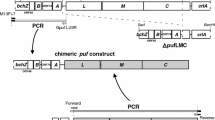Abstract
A protein closely resembling the purple membrane protein pre-exists in the cell membrane of H. halobium prior to the appearance of functional bacteriorhodopsin. It is associated with a differentiated membranous structure which has been isolated on a sucrose gradient and appears to be a precursor of the purple membrane. The identity of the precursor protein as a form of the purple membrane protein was established in different ways: (1) The cell proteins were labelled in vivo with 14C-proline during dark aerobic growth, the label was “chased”, and the cells transferred to the illuminated near-anaerobic conditions under which purple membrane is optimally synthesised (induction conditions). Cell lysates were fractionated on sucrose gradients at different times after induction. Label first found in the precursor fraction appeared within 24 h in the purple membrane fraction. (2) SDS-urea-acrylamide gel electrophoresis of the purple membrane protein and the precursor showed only one protein band whose migration coincided with that of the purple membrane band. (3) The amino-acid analysis of the purified precursor was very similar to that of the purple membrane.
The absorption spectrum of the precursor showed little of the characteristic absorption of bacteriorhodopsin at 570 nm. A major band appears at 412 nm, the exact nature of which is not known. The difference spectrum (reduced versus oxidised) of a purified fraction showed only traces of cytochrome. Thin-layer chromatography of an acetone-soluble lipid extract indicated the presence of retinal and Β-carotene. Cells grown in the presence of nicotine did not develop purple membrane after induction: the species absorbing at 412 nm was much less abundant than in non-inhibited cells, but a new fraction was present with a sharp peak at 345 nm consisting mainly of lycopene.
Similar content being viewed by others
Abbreviations
- CTAB:
-
cetyltrimethyl ammonium bromide
- SDS:
-
sodium dodecyl sulfate
- CAP:
-
chloramphenicol
- TLC:
-
thin layer chromatography
- CD:
-
circular dichroism
References
Bayley, S. T., Kushner, D. J.: The ribosomes of the extreme halophilic bacterium Halobacterium halobium. J. molec. Biol. 9, 654–669 (1964)
Blaurock, A. E.: Bacteriorhodopsin. A trans-membrane pump containing α-helix. J. molec. Biol. 93, 139–148 (1975)
Blaurock, A. E., Stoeckenius, W.: Structure of the purple membrane. Nature (Lond.) New Biol. 233, 152–154 (1971)
Danon, A., Stoeckenius, W.: Photophosphorylation in Halobacterium halobium. Proc. nat. Acad. Sci. (Wash.) 71, 1234–1238 (1974)
Danon, A., Caplan, S. R.: Stimulation of ATP synthesis in Halobacterium halobium. Biochim. biophys. Acta (Amst.) 423, 133–140 (1976)
Goodwin, T. W.: Recent developments in the biosynthesis of carotenoids. Biochemical Society Symposia, vol. 35. Current trends in the biochemistry of lipids, pp. 210–231. New York: Academic Press 1972
Henderson, R.: The structure of the purple membrane from Halobacterium halobium. Analysis of the X-ray diffraction pattern. J. molec. Biol. 93, 123–138 (1975)
Henderson, R., Unwin, P. N. T.: A three dimensional model of purple membrane obtained by electron microscopy. Nature (Lond.) 257, 28–32 (1975)
Heyn, M. P., Bauer, P. J., Dencher, N. A.: A natural CD label to probe the structure of the purple membrane from Halobacterium halobium by means of exciton coupling effects. Biochem. biophys. Res. Commun. 67, 897–903 (1975)
Howes, C. D., Batra, P. P.: Accumulation of lycopene and inhibition of cyclic carotenoids in myobacterium in the presence of nicotine. Biochim. biophys. Acta (Amst.) 222, 174–179 (1970)
Kushwaha, S. C., Kates, M., Martin, W. G.: Characterization and composition of the purple red membrane of Halobacterium cutirubrum. Canad. J. Biochem. 53, 284–292 (1975)
Lewis, L., Smith, C. D., Kim, M.: Resonance Raman spectroscopic evidence that the pigment responsible for the phototransduction in the Aplysia R-2 neuron is Β-carotene. Nature (Lond.) (in press)
Lowry, B. H., Rosebrough, N. J., Farr, A. L., Randall, R. J.: J. biol. Chem. 193, 265–275 (1951)
Oesterhelt, D., Stoeckenius, W.: Rhodopsin-like protein from the purple membrane of Halobacterium halobium. Nature (Lond.) New Biol. 233, 149–152 (1971)
Oesterhelt, D., Stoeckenius, W.: Functions of a new photoreceptor membrane. Proc. nat. Acad. Sci. (Wash.) 70, 2853–2857 (1973)
Oesterhelt, D., Meentzen, M., Schuhmann, L.: Reversible dissociation of the purple complex in bacteriorhodopsin and identification of 13-cis and all-trans retinal as its chromophore. Europ. J. Biochem. 40, 453–463 (1973)
Oesterhelt, D.: Isolation of a lycopene containing membrane with unusual spectroscopic properties from Halobacterium halobium, Abstr. Comm. Meeting Fed. Europ. Biochem. Soc. 8, Abstr. No. 125 (1972)
Onishi, H., McChance, M. E., Gibbons, N. E.: A synthetic medium for extremely halophilic bacteria. Canad. J. Microbiol. 11, 365–373 (1965)
Rimai, L., Kilponen, R. G., Gill, D.: Excitation profiles and laser Raman spectra in the resonance region of two carotenoid pigments in solution. J. Amer. chem. Soc. 92, 3824–3825 (1970)
Singh, H., Mallia, A. K., Cama, H. R.: Chemistry and metabolism of apocarotenals and their epoxides. Biochemical Society Symposia, vol. 35. Current trends in the biochemistry of lipids, pp. 210–231. New York: Academic Press 1972
Stanley, P. E., Williams, S. G.: Use of the liquid scintillation spectrometer for determining adenosine triphosphate by the Luciferase enzyme. Analyt. Biochem. 29, 381–392 (1969)
Stoeckenius, W., Rowen, R.: A morphological study of Halobacterium halobium and its lysis in media of low salt concentration. J. Cell Biol. 344, 365–393 (1967)
Sumper, M., Reitmaier, H., Oesterhelt, D.: Biosynthesis of the purple membrane of halobacteria. Angew. Chem. Int. Ed. Engl. 15, 187–194 (1976)
Tornabene, T. G., Kates, M., Gelpe, E., Oro, J.: Occurrence of squalene, di- and tetrahydrosqualenes and vitamins MK8 in an extremely halophilic bacterium, Halobacterium cutirubrum. J. Lipid Res. 10, 294–303 (1969)
Weber, K., Osborn, M.: The reliability of molecular weight determinations by dodecyl sulfate-polyacryl-amide gel electrophoresis. J. biol. Chem. 244, 4406–4412 (1969)
Author information
Authors and Affiliations
Rights and permissions
About this article
Cite this article
Danon, A., Brith-Lindner, M. & Caplan, S.R. Biogenesis of the purple membrane of Halobacterium halobium. Biophys. Struct. Mechanism 3, 1–17 (1977). https://doi.org/10.1007/BF00536449
Received:
Accepted:
Issue Date:
DOI: https://doi.org/10.1007/BF00536449




